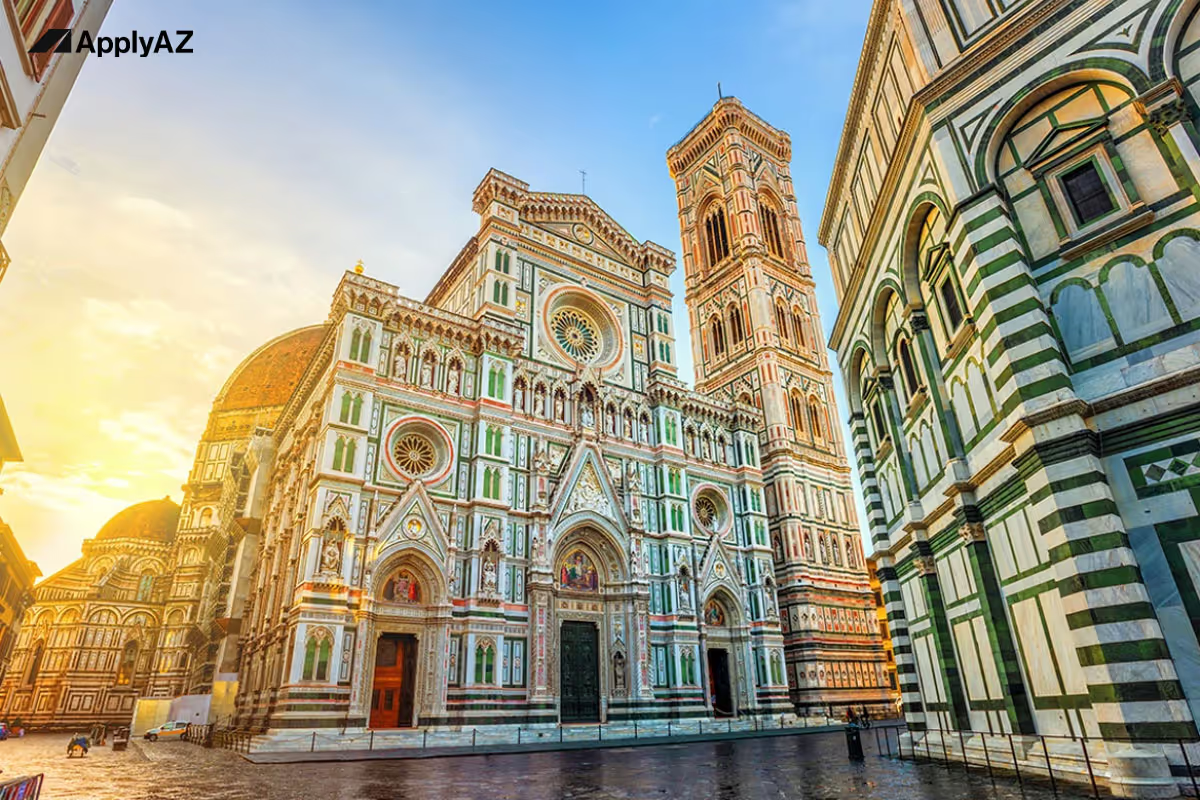Heading
Heading








University of Florence (Università degli Studi di Firenze)
A centuries‑old public university with modern ambitions
Founded in 1321, the University of Florence is one of the most respected public Italian universities. Today it welcomes more than 50,000 students and offers a growing catalogue of English‑taught programs in Italy across engineering, economics, natural sciences, and design. International league tables place its civil engineering and agriculture departments in Europe’s top 150. Research parks in medicine, photonics, and sustainable architecture feed breakthroughs directly into master’s classrooms.
Why “study in Italy in English” makes sense here
Florence hosts nine fully English master’s tracks and many bilingual courses, so you can progress without Italian at day one. Academic advisors encourage language lessons on the side, but lectures, labs, exams, and thesis defences remain in English. Tuition follows the predictable brackets set for public Italian universities, typically €800–€2,300 per year depending on family income. Pair those fees with the DSU grant—Italy’s regional right‑to‑study scholarship—and living costs fall sharply, sometimes matching totals quoted for tuition‑free universities Italy advocates discuss. Extra scholarships for international students in Italy reward high GPA or research talent, cutting expenses further.
Florence: more than Renaissance art
Student life and affordability
Florence may be a global tourist magnet, yet students discover affordable corners. Shared flats in residential districts like Novoli or Campo di Marte cost around €350 a month. University canteens serve two‑course meals for about €4, and the DSU meal card can bring that to zero. A €38 monthly pass covers buses and trams; most classrooms sit within cycling range anyway. Mild winters and warm summers invite year‑round study breaks along the Arno riverbanks.
Culture and community
Beyond the Uffizi and Duomo lies a network of student associations: Erasmus groups run language tandems, while the university sports centre organises rowing on the Arno and weekend hikes in Chianti. Live jazz bars, experimental theatres, and open‑air cinemas keep evenings lively without breaking budgets. Museums grant free entry once a month—perfect for art‑history revision sessions.
Jobs, internships, and innovation hubs
Florence’s economy extends far beyond tourism. Fashion giants like Gucci and Salvatore Ferragamo hire design engineers, data analysts, and sustainability officers. The city’s biomedical district hosts device manufacturers and EU research consortia; engineering students often intern on 3‑D printed implants or wearable sensors. In nearby Sesto Fiorentino, the Optoelectronics Research Centre collaborates with physics and materials departments on lasers and fibre‑optic components. Agrifood science students tap the surrounding Tuscan countryside to trial precision‑farming drones and circular‑economy fertilisers. Many internships convert into part‑time roles, which Italian law lets non‑EU students hold up to 20 hours per week.
Support that smooths your academic journey
The International Desk guides enrolment, visa steps, and housing searches. Welcome Week pairs newcomers with peer mentors who explain tram routes, exam booking portals, and Italian phone plans. Career Services run CV clinics and mock interviews in English, preparing you for regional job fairs where 200+ firms scout STEM and business talent. Language Centre courses move you from A1 survival phrases to B2 professional dialogue, opening more local internship options by year two.
Your Florence advantage in four bullet points
- World‑class teaching in a UNESCO city where breakthroughs in art, science, and finance were born.
- Balanced budget thanks to DSU grant, merit scholarships, and low regional tuition.
- Vibrant network of fashion houses, biomedical labs, fintech start‑ups, and sustainable vineyards ready for interns.
- Cultural immersion through free museum days, language cafés, and the ease of weekend trips to Rome, Bologna, or the Tuscan coast.
In two minutes we’ll confirm whether you meet the basic entry rules for tuition-free, English-taught degrees in Italy. We’ll then quickly see if we still have space for you this month. If so, you’ll get a personalised offer. Accept it, and our experts hand-craft a shortlist of majors that fit your grades, goals, and career plans. Upload your documents once; we submit every university and scholarship application, line up multiple admission letters, and guide you through the visa process—backed by our admission-and-scholarship guarantee.
Design of Sustainable Tourism Systems (LM‑49) at University of Florence
1. Gateway to sustainable tourism leadership
Choosing among English‑taught programs in Italy can be daunting, yet this LM‑49 course lets you study in Italy in English while paying the controlled fees of public Italian universities. Scholarships such as the DSU grant push net costs close to figures claimed by some tuition‑free universities Italy conversations, without sacrificing top‑tier research labs or mentorship. The programme forges managers who combine design thinking, data analytics, and ecological ethics to reinvent tourism for net‑zero goals.
2. Programme blueprint: four semesters, 120 ECTS, one clear mission
Semester 1 – foundations in sustainability and systems thinking
- Principles of Sustainable Tourism (9 ECTS)
Trace the evolution of carrying capacity, circular economy, and UN Sustainable Development Goals (SDGs). Weekly workshops map stakeholder needs and life‑cycle impacts. - Service Design Fundamentals (6 ECTS)
Learn journey mapping, persona crafting, and rapid prototyping. Students redesign a heritage‑site booking flow with Figma. - Quantitative Methods for Tourism (6 ECTS)
Apply statistics, R, and Python to demand forecasting and seasonality smoothing. Mini‑projects scrape open data and visualise trends. - Environmental Economics (4 ECTS)
Evaluate ecosystem services, externalities, and carbon pricing. Case studies compare coastal versus mountain levy schemes. - Research and Academic Writing (5 ECTS)
Craft concise abstracts, citation ethics, and literature reviews—skills vital for thesis and journal submission.
Semester 2 – digital tools, policy, and visitor experience
- Digital Marketing and Analytics (9 ECTS)
Explore SEO, campaign attribution, and social listening. Labs in Google Analytics 4 assess conversion funnels for eco‑lodges. - International Tourism Policy (6 ECTS)
Examine WTO agreements, visa regimes, and heritage conventions. Mock debates propose resilient tourism charters. - Experience Design Studio (6 ECTS)
Blend storytelling, multisensory cues, and accessibility. Prototypes receive peer feedback in sprint reviews. - Sustainable Supply‑Chain Management (5 ECTS)
Map suppliers, measure scope 3 emissions, and draft zero‑waste procurement plans. - Elective A (4 ECTS)
Choose Climate Risk Modelling, Smart Mobility, or Ethical AI in Tourism.
Semester 3 – integration, finance, and innovation
- Impact Finance and Funding Models (8 ECTS)
Study green bonds, blended finance, and social‑impact metrics. Teams build financial models for regenerative tourism hubs. - Data‑Driven Decision Support (6 ECTS)
Build dashboards in Power BI and Tableau. Projects merge weather, transport, and booking datasets to guide capacity management. - Behavioural Change and Visitor Nudging (6 ECTS)
Leverage behavioural economics to reduce water use, plastic waste, and overtourism. A‑B tests run on simulated booking engines. - Elective B (4 ECTS)
Options include Ecotourism Product Development, Heritage Tech, or Blue Economy Tourism. - Innovation Lab (6 ECTS)
Six‑week sprint: validate an eco‑tourism start‑up idea until MVP. Venture mentors critique pitch decks.
Semester 4 – internship and thesis
- Professional Internship (18 ECTS)
At least 450 hours with consultancies, NGOs, or research institutes. Roles might model carbon footprints, draft regenerative master plans, or build visitor datasets. Weekly journals tie field tasks to academic theory. - Master’s Thesis (30 ECTS)
Original research or product prototype. Recent titles: “Blockchain Traceability for Agritourism,” “AI‑Driven Dynamic Pricing to Boost Off‑Season Demand,” and “Net‑Zero Roadmap for UNESCO Sites.” Target output: journal article or investor prospectus.
3. Teaching approach: flipped, agile, and feedback‑rich
Professors release 10‑minute video capsules one week in advance. Classroom hours turn into design critiques, scenario games, and code reviews. Each four‑week cycle follows:
- Plan – set deliverables and KPIs.
- Build – collect data, mock‑up visuals, or draft policy memos.
- Demo – present five‑minute stand‑ups for peer questions.
- Retro – analyse feedback and refine.
This agile rhythm mirrors real consulting or start‑up practice, honing leadership and collaboration.
4. Laboratories and digital resources
- Experience Prototyping Lab – VR headsets and scent diffusers test immersive narratives.
- Sustainability Analytics Hub – high‑performance workstations with R, Python, and GIS for climate and waste modelling.
- Behavioural Insight Suite – eye‑tracking and galvanic sensors measure visitor reactions to signage and kiosk layouts.
- Service Design Workshop – rapid‑fabrication tools (laser cutters, 3‑D printers) create wayfinding prototypes.
- Impact Finance Studio – Bloomberg terminals and ESG databases support bond structuring and risk profiling.
Booking slots run online; lab ratios rarely exceed five students per instructor.
5. Competencies you will gain
- Systems thinking – map tourism value webs and flag leverage points.
- Data literacy – produce SQL queries, dashboards, and machine‑learning forecasts.
- Design mastery – craft inclusive, low‑impact visitor experiences.
- Policy fluency – interpret global and regional tourism laws, carbon targets, and accessibility codes.
- Financial acumen – model cash flows and impact KPIs for grants and blended finance.
- Leadership in English – present concise pitches, lead retrospectives, and write scholarly papers.
6. Research hotbeds and project opportunities
Faculty coordinate EU Horizon projects on regenerative coastlines, AI‑enabled visitor flows, and heritage digitisation. Master’s students join as research assistants, earning stipends while gaining co‑author status. Industry partners—eco‑resorts, smart‑mobility start‑ups, and heritage foundations—co‑supervise theses, ensuring field data and immediate application.
7. Career destinations and certifications
Graduates land roles such as:
- Sustainable Tourism Consultant
- Destination Management Analyst
- ESG Officer for hospitality groups
- Experience Designer in museum tech firms
- Research PhD candidate in tourism geography
The curriculum aligns with the Global Sustainable Tourism Council (GSTC) knowledge base and offers exam coaching for LEED Green Associate and PRINCE2 Foundation, enriching your résumé.
8. Funding and cost management
- Tuition band – €800–€2,300 depending on family income, consistent with public Italian universities.
- DSU grant – may waive tuition, supply meal vouchers, subsidise rent, and deliver up to €7,000 stipend, renewed on 30 ECTS progress.
- Merit scholarships – fee cuts for GPAs above 3.5/4.0 or GRE Analytical Writing ≥ 4.5.
- Research bursaries – €3,000–€5,000 for EU project assistants.
- Erasmus+ mobility grants – fund a semester at partner universities focused on coastal or mountain tourism.
These layers can reduce net spending to figures close to those advertised by tuition‑free universities Italy discussions—while you access premium labs and coaching.
9. Step‑by‑step admission
- Bachelor’s degree in tourism, business, geography, design, or environmental science.
- Prerequisites – statistics, basic economics, and introductory design or planning module.
- English proficiency – IELTS 6.5, TOEFL 90, or prior English‑medium degree.
- Document package – transcript, CV, passport, motivation letter, two references.
- Online interview – 20 minutes: discuss a project, answer rapid‑fire tourism scenarios, and test design vocabulary.
10. Distinct advantages at a glance
- Entire programme in English—ideal for global sustainability careers.
- Agile teaching mirrors consultancy sprints, fostering market‑ready skills.
- Labs blend VR, behavioural science, and impact finance—rare in one course.
- Public‑university fees plus generous scholarships for international students in Italy keep budgets predictable.
- Faculty research feeds live projects, letting master’s students publish before graduation.
- Graduates secure roles across consulting, hospitality, NGOs, and PhD tracks.
Ready for this programme?
If you qualify and we still have a spot this month, we’ll reserve your place with ApplyAZ. Our team will tailor a set of best-fit majors—including this course—and handle every form and deadline for you. One upload, many applications, guaranteed offers, DSU grant support, and visa coaching: that’s the ApplyAZ promise. Start now and secure your spot before this month’s intake fills up.

They Began right where you are










